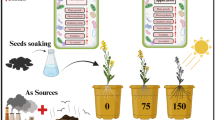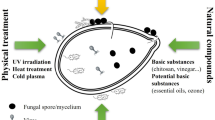Abstract
Evaluation of selected parameters viz. initial germination percentage (IGP), soaking duration (SD), process temperature, rotation speed (rpm) and air flow rate (AFR) was performed in this research investigation for hydropriming of Pea (Pisum sativum) seeds. Three seed lots having difference in their moisture content (14.94–28.04 % d.b) and germination percentage (60–80 %) were selected in this study. Procured seed lots were subjected to variable duration of accelerated aging (40 ± 1 °C, 100 % RH) to attain necessary seed lots for experimental run. Response surface methodology (Box–Behnken design) with five factors and three-level combination was adopted, and the independent variables are germination percentage (80, 70, 60), soaking duration (45, 60, 75 min), temperature (20, 25, 30 °C), rotation speed (320, 340, 360 rpm) and air flow rate (0.411, 0.548, 0.685 m3/min). Second order polynomial equation was fitted for analyzing the experimental data and data was also subjected to analysis of variance as a part of regression analysis. Process responses which were selected to evaluate the effect of hydropriming were moisture content after hydropriming, final germination percentage, seedling length, seedling dry weight, vigor indices (VI–I and VI–II) and electrical conductivity. Regression analysis suggested that models were significant for all process responses and using numerical optimization technique, the optimal solution found was 75 % IGP, 55 min SD, 20 °C temperature, 320 rpm and 0.50 m3/min AFR. Values predicted by model were found to be at par with the results of a confirmation experiment carried out at optimum conditions.








Similar content being viewed by others
Abbreviations
- IGP:
-
Initial germination percentage
- T:
-
Temperature
- AFR:
-
Air flow rate
- ANOVA:
-
Analysis of variance
- FGP:
-
Final germination percentage
- SDW:
-
Seedling dry weight
- VI-II:
-
Vigor index-II
- d.b.:
-
Dry basis
- L2 :
-
Seed lot 2
- MT:
-
Metric ton
- RSM:
-
Response surface methodology
- mS/cm:
-
Millisiemens/centimetre
- SD:
-
Soaking duration
- rpm:
-
Rotation speed
- RH:
-
Relative humidity
- MC:
-
Moisture content
- SL:
-
Seedling length
- VI–I:
-
Vigor index-I
- EC:
-
Electrical conductivity
- L 1 :
-
Seed lot 1
- L 3 :
-
Seed lot 3
- Mha:
-
Million hectare
- BBD:
-
Box–Behnken design
- min:
-
Minute
References
Abdolahi M, Andelibi B, Zangani E, Shekari F, Somarin SJ (2012) Effect of accelerated aging and priming on seed germination of rapeseed (Brassica napus L.) cultivars. Int Res J Appl Basic Sci 3(3):499–508
Abdul-Baki A, Anderson JD (1973) Vigor determination in soybean seed by multiple criteria. Crop Sci 13:630–633
Abdulrahmani B, Ghassemi-Golezani K, Valizadeh M, Feizi-Asl V (2007) Seed priming and seedling establishment of barley (Hordeum vulgare L.). J Food Agric Environ 5:179–184
Ashraf M, Rauf H (2001) Inducing salt tolerance in maize (Zea mays L.) through seed priming with chloride salts: growth and ion transport at early growth stages. Acta Physiol Plant 23:407–414
Box GEP, Draper NR (1987) Empirical model building and response surfaces. Wiley, New York, p 477
Bradford KJ (1986) Manipulation of seed water relations via osmotic priming to improve germination under stress conditions. Hortic Sci 21:1105–1112
Ellis RH, Roberts EH (1981) The quantification of ageing and survival in orthodox seeds. Seed Sci Technol 9:373–409
Ferreira SLC, Bruns RE, Ferreira HS, Matos GD, David JM, Brandao GC, Da Silva EGP, Portugal LA, dos Reis PS, Souza AS, dos Santos WNL (2007) Box–Behnken design: an alternative for the optimization of analytical methods. Anal Chim Acta 597:179–186
Goela A, Goelb AK, Sheorana IS (2003) Changes in oxidative stress enzymes during artificial aging in cotton (Gossypium hirsutum L.) seeds. J Plant Physiol 160:1093–1100
Guan YJ, Hu J, Li YP, Zheng YY (2011) A new anti-counterfeiting method: fluorescent labeling by safranine T in tobacco seed. Acta Physiol Plant 33:1271–1276
Harris D (1992) The effects of manure, genotype, seed priming, depth and date of sowing on the emergence and early growth of Sorghum bicolor (L.) Moench in semi-arid Botswana. Soil Till Res 40:73–88
Harris D, Tripathi RS, Joshi A (2001) On-farm seed priming to improve crop establishment and yield in direct-seeded rice. In: IRRI: International Workshop on Dry-seeded Rice Tech
Indian Minimum Seed Certification Standards (2013) The Central Seed Certification Board, Department of Agriculture and Co-operation, Ministry of Agriculture, Government of India, New Delhi
ISTA (1993) International rules for seed testing. Seed Sci Technol 21:141–186
Kalil SJ, Maugeri F, Rodrigues MI (2000) Response surface analysis and simulation as a tool for bioprocess design and optimization. Proc Biochem 35:539–550
Kaya MD, Okc UG, Atak MC, Ikili Y, Kolsarici O (2006) Seed treatments to overcome salt and drought stress during germination in sunflower (Helianthus annuus L.). Eur J Agron 24:291–295
Khuri AI, Cornell JA (1987) Response surfaces designs and analysis. Marcel Decker, New York
Khuri AI, Mukhopadhyay S (2010) Response surface methodology. WIREs. Comput Stat 2:128–149
Kibinza S, Vinel D, Côme D, Bailly C, Corbineau F (2006) Sunflower seed deterioration as related to moisture content during ageing, energy metabolism and active oxygen species scavenging. Physiol Plant 128:496–506
Mehta DK, Kanwar HS, Thakur AK, Thakur KS (2010) Influence of organic seed priming on germination and seedling quality in bell pepper (Capsicum annuum L.). J Hill Agric 1(1):85–87
Mohammadi GR, Dezfuli MPM, Sharifzadeh F (2008) Seed invigoration techniques to improve germination and early growth of inbred line of maize under salinity and drought stress. Gen Appl Plant Physiol 34:215–226
Musa AM, Harris D, Johansen C, Kumar J (2001) Short duration chickpea to replace fallow after aman rice: the role of on-farm seed priming in the High Barind Tract of Bangladesh. Exp Agric 37(4):509–521
National Horticulture Board (2014) Indian Horticulture Database. Ministry of Agriculture, Government of India
Nawaz J, Hussain M, Jabbar A, Nadeem GA, Sajid M, Subtain M, Shabbir I (2013) Seed Priming A technique. Int J Agric Crop Sci 6–20:1373–1381
Pandey DK (1989) Priming induced alleviation of the effects of natural ageing derived selective leakage of constituents in French bean seeds. Seed Sci Technol 17:391–397
Perry DA (1981) Report of the Vigor Test Committee 1977–1980, vol 9. Seed Technology, Zurich, pp 115–126
Presley JT (1958) Relations of protoplast permeability of cotton seed viability and pre-deposition of disease. Plant Dis Rep 42:582
Radha BN, Channakeshava BC, Bhanuprakash K, Pandurange Gowda KT, Ramachandrappa BK, Munirajappa R (2014) DNA damage during seed ageing. J Agric Vet Sci 7(1):34–39
Rana B, Awasthi P, Kumbhar BK (2012) Optimization of processing conditions for cyanide content reduction in fresh bamboo shoot during NaCl treatment by response surface methodology. J Food Sci Technol 49(1):103–109
Rudrapal D, Naukamura S (1988) The effect of hydration-dehydration pre treatments on egg plant and radish seed viability and vigor. Seed Sci Technol 16:123–130
Simak M (1991) Testing of forest tree and shrub seeds by X-radiography. In: Gordon AG, Gosling P, Wang BSP (eds) Tree and shrub seed handbook. International Seed Testing Association, Zurich, pp 141–1428
Stofella PJ, Paola MLD, Pardossi A, Tognoni F (1992) Seedling root morphology and shoot growth after seed priming or pre-germination of bell pepper. Hortic Sci 27:214–215
Suthar SH, Das SK (1996) Some physical properties of karingda [Citrullus lanatus (thumb) Mansf] seeds. J Agric Eng Res 65(1):15–22
Takayanagi K, Murakami K (1968) Rapid germinability test with exudates from seed. Nature 218(5140):493–494
Varier A, Kuriakose A, Dadlani M (2010) Subcellular basis of seed priming. Curr Sci 99:450–456
Yogalakshmi J, Ponnuswamy AS, Karivartharaju JV (1996) Seed storage potential of rice hybrid (CORH-1) and parental lines. Madras Agric J 83:829–832
Acknowledgments
The first author acknowledges University Grants Commission (UGC) for providing financial support in the form of Rajiv Gandhi National Fellowship. Also, gratitude is extended to Division of Agricultural Engineering, Seed Science and Technology, ICAR-IARI New Delhi and ICAR-NBPGR, New Delhi for providing research infrastructure and laboratories facilities.
Author information
Authors and Affiliations
Corresponding author
Additional information
Communicated by S. Weidner.
Rights and permissions
About this article
Cite this article
Mahawar, M.K., Samuel, D.V.K., Sinha, J.P. et al. Optimization of pea (Pisum sativum) seeds hydropriming by application of response surface methodology. Acta Physiol Plant 38, 212 (2016). https://doi.org/10.1007/s11738-016-2234-3
Received:
Revised:
Accepted:
Published:
DOI: https://doi.org/10.1007/s11738-016-2234-3




